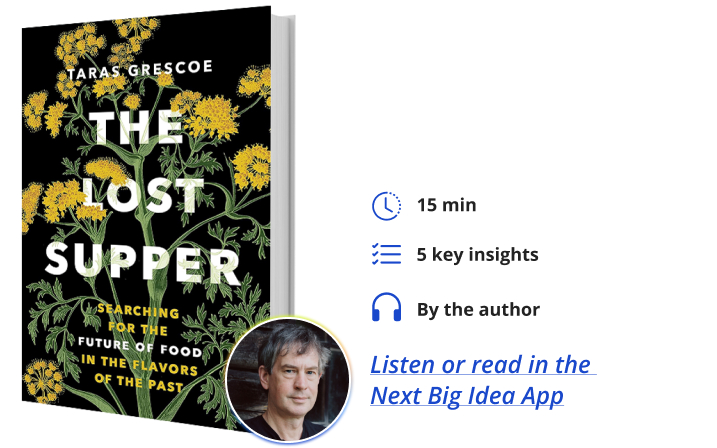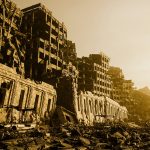Taras Grescoe is a journalist, travel writer, and author of several nonfiction titles, such as Straphanger, Bottomfeeder, and The End of Elsewhere. He is also a contributor to an assortment of publications, including the New York Times Magazine, National Geographic Traveler, and The Wall Street Journal.
Below, Taras shares five key insights from his new book, The Lost Supper: Searching for the Future of Food in the Flavors of the Past. Listen to the audio version—read by Taras himself—in the Next Big Idea App.

1. We may now be able to taste the past.
For a long time, food historians have been aware that the ancient world had a mysterious secret sauce known as garum. It appears in almost every recipe in Apicius, the biggest compendium of recipes that survives from Roman times. In Spain, I met with a team of food scientists and archaeologists who used gas chromatography and electron scanning microscopes to analyze residue within amphora recovered from the eruption of Vesuvius in the year 79. Relying on original recipes and evidence from the organic remains, they were able to recreate this umami-rich sauce made of small, fermented fish. They recruited top chefs in the city of Cadiz, Spain to cook with their recreated garum. I got to sample some of their dishes, and the results were spectacular.
I decided to make my own garum. Under the guidance of a British expert in Roman cookery, I spent three months fermenting garum from Portuguese sardines. It’s now become a secret ingredient in my own cooking; it brings savory intensity to all kinds of stews and pasta sauces. Making garum was a way of discovering how unfamiliar—but also how delicious—ancient cooking really was. I realized the Roman mix of sweet, sour, and savory has more in common with Cantonese cooking than it does with modern Italian food.
When it comes to food, the secret to time travel is that humans alive today are identical in physique, intelligence, and problem-solving abilities to just about anybody who has lived in the last sixty thousand years. When confronted with a problem—like how to build shelter or assemble a meal—our ancestors drew on the same set of innate capacities that we possess today. The challenge is to see the world through their eyes. Once you know that, the only things you need to go into the past are curiosity and imagination.
2. Food security in the future lies in the diversity of foods we ate in the past.
The world is undergoing a huge drop in biodiversity. Global heating, pollution, overfishing, and habitat destruction mean that the rate of species extinction is hundreds of times faster than it has been in the last ten million years. According to some estimates, a quarter of the 8.7 million known plant and animal species alive today are likely to become extinct over the next few decades.
Agrobiodiversity, which refers to the range of plants and livestock that feed us, is also in decline. A tenth of the 6,000 or so breeds of domesticated animals used in agriculture are already extinct. Every month, a half dozen more are lost forever. The same is happening with traditional crop varieties. Since 1900, three-fourths of the genetic diversity once stored in farmers’ fields has been lost.
“In the United States, nine out of ten gallons of milk comes from just one breed of cow: the Holstein-Friesian, all of which are descended from just two bulls.”
If you go into a Whole Foods or Trader Joe’s, loss of diversity might not seem a big issue. High-end supermarkets stock organic beef, microbrews, heirloom tomatoes, kale, and once-exotic cereals like quinoa, amaranth, and spelt—foods imported from around the world. But behind this apparent embarrassment of riches, there’s a poverty of real nutritional content. In the United States, nine out of ten gallons of milk comes from just one breed of cow: the Holstein-Friesian, all of which are descended from just two bulls. The majority of the world’s pork production is now based on the genetics of a single breed of pig: the white Danish Landrace. The market for seeds, the ultimate source of all the world’s crops, is controlled by just four multinational corporations. And half of the calories consumed on Earth now come from just three grasses, all of them subject to either genetic modification or scientific hybridization: rice, corn, and wheat.
Fortunately, there’s hope for the future of food—though the solution might strike some as counterintuitive. When it comes to tigers, whales, elephants, and other endangered wildlife, the best we can do is spare them from predation, exploitation, and give them room to live—in other words, leave them alone. As for the ancestral grains, wild yeasts, and forgotten livestock breeds that have enriched the human diet over the ages, the way forward lies in reviving them, cultivating them, herding them—and consuming them. To save it, you’ve got to eat it.
3. Lack of diversity in modern diets is bad for our health.
In recent years, seed oils like sunflower and canola have replaced olive oil in Mediterranean nations, reducing life spans in a region once synonymous with good cardiovascular health, leanness, and longevity. Around the world, the loss of diversity means a sharp drop in the omega-3 fatty acids, polyphenols, and other micronutrients essential for good health. The triumph of what some nutritionists call the “Global Standard Diet” has also led to an increase in the diseases of civilization: hypertension, cancer, arthritis, asthma, diabetes, heart disease, as well as the complex of conditions known as metabolic syndrome. For the first time in two centuries, poor nourishment means children in the United States are expected to live shorter lives than their parents.
Consider this: At a single 23,000-year-old site in Africa’s Rift Valley, archaeologists have found evidence that Paleolithic foragers feasted on 20 small and large animals, 16 families of birds, and 140 different kinds of fruit, nuts, seeds, and legumes. One well-preserved early Iron Age man recovered from a bog in Denmark had sixty different plant species in his stomach—all of them consumed in the day or two before he died. Anthropologists have found that the Hadza (nomads in northern Tanzania, counted among the last of the world’s hunter-gatherers), consume 800 distinct plant and animal species.
Yet of the ten thousand plants that have nourished Homo sapiens over the millennia, only 150 are cultivated for food today, and just fourteen animal species provide 90 percent of the calories we get from livestock. Since the last two agricultural revolutions, the Industrial and the Green Revolution, we’ve cast our lot with monocultures of a few staple crops, with rice, wheat, corn, soybeans, and sugar cane at the top of the list. These monocrops have allowed the human population to increase to 8 billion, while leaving over 800 million of us chronically undernourished.
The latest research shows that people who have a diverse diet—which means they eat thirty different kinds of plants and animals a week—are significantly freer from disease than even people who eat an exclusively vegan and vegetarian diet. Diversity is resiliency.
4. We need diversity in the field.
The crops and livestock we rely on to feed us are in trouble. On the shores of the Mediterranean, olive trees, some of them 2,000 or more years old, are turning black and dying, victims of a disease called Xylella fastidiosa. I went to the olive groves of Puglia, in the south of Italy, and was shocked to see what’s become of a landscape that goes back to the times of the ancient Greeks: the giant millennial trees are dying. All that’s left in some places are forests of skeletons. This is playing havoc with the global supply of one of the healthiest kinds of fats you can consume: extra virgin olive oil.
“The problem is that seeds kept inert in cold storage aren’t evolving with and adapting to changes in the environment.”
Humanity’s backup plan, unfortunately, is to keep the seeds and semen of plants and livestock in gene banks. There’s a gene bank for olives in Cordoba, Spain, another for wheat in Morocco, for corn in Mexico, and the mother of them all, the Svalbard Global Seed Vault, which is located north of the Arctic Circle on an island halfway between the Norwegian mainland and the North Pole. The problem is that seeds kept inert in cold storage aren’t evolving with and adapting to changes in the environment.
Farmers in southern Italy found that certain olive varieties were resistant to Xyella fastidiosa, and if you grafted them onto trees before they got sick, entire orchards could be saved. The same threat exists for coffee, whose habitat is threatened by increased rainfall and heat; for grains, which can be wiped out by diseases like wheat rust; and for wine, as rising temperatures threaten the production of common grape varietals in Bordeaux and the Napa Valley. The best hope for important species is to find their wild relatives, plant them, cultivate them—and eat them.
5. The quest for novel and intense flavors drives physical and cultural evolution.
There’s a tendency, among historians and anthropologists, to push food and drink to the margins. For many scholars, food is filed away under the heading of “energetics.” The idea being: Who cares what the workers building the pyramids were eating? What’s important to us is the lives of the pharaohs and priests.
I make the case that the sourdough bread and beer the ancient Egyptians ate—as well as the food that nourished the Maya, or the Hittites, or the ancient Khmer—is just as worthy of our interest as temple architecture and royal dynasties.
The first times hominins used tools, as shown by the behavior of our chimpanzee cousins, might well have been to root out tasty grubs, ants, and termites. One of the most convincing explanations for why our species learned to master fire was that meat tasted so much better roasted than raw. Hunger and famine probably called the shots at many points in our story, but I believe that—ever-adaptable omnivores that we are—the reason we bothered going over the hilltop, or to the far side of the river, was often to discover how things tasted over there. Our spread as a species, in other words, was driven by our penchant for adventurous eating.
Some historians and anthropologists, among them Jared Diamond and Yuval Harari, have made the claim that agriculture is the greatest mistake in the history of the human race: it led to pandemics, oppression, inequality, and shorter life spans. The Lost Supper makes the case that you can’t blame farming for the ills of civilization. What we can say is that the way we’re doing agriculture is all wrong. We need to de-industrialize food production to preserve the health of the soil and our water supply. Doing so could slow down both economic and population growth—but, given the signs of global ecosystem collapse, that might not be a bad thing.
If there’s one thing I discovered in my exploration of humanity’s relationship with food—from the quest for the long-lost Roman herb silphion to the pursuit of the ultimate cut of Spanish ham—is that flavor isn’t a footnote in history. Deliciousness really, really matters.
To listen to the audio version read by author Taras Grescoe, download the Next Big Idea App today:





























